- Home
- Kim Newman
The Man From the Diogenes Club Page 44
The Man From the Diogenes Club Read online
Page 44
Of Richard’s doings between the War and the Seamouth Case, Fred knew not much. After Geoffrey’s death in 1954, Richard’s sponsors at the Club had been Edwin Winthrop, now dead but well remembered, and Sir Giles Gallant, now retired and semi-disgraced. Vanessa came into the picture well before the Seamouth Case. She had Richard’s habit of being evasive without making a fuss about it. All Fred knew was that her first meeting with their patron was another horror story. Whenever it came up, she’d touch the almost-invisible scar through her eyebrow and change the subject with a shudder.
‘Now we’re near the end of the line,’ said Richard, ‘perhaps you should hear the tale.’
They were here for the night. Time enough for a ghost story.
‘Frederick,’ said Richard, ‘it was 195—, and I was down from Oxford…’
ACT I: LONDON EUSTON
I.
It was 195— and Richard Jeperson was down from Oxford. And the LSE. And Cambridge. And Manchester Poly. And RADA. And Harrow School of Art. And… well, suffice to say, many fine institutions, none of which felt obliged to award him any formal qualification.
Geoffrey Jeperson had sent him to St Cuthbert’s, his old school. Richard hadn’t lasted at ‘St Custard’s’, setting an unhappy precedent insofar as not lasting at schools went. After the Captain’s death, Edwin Winthrop took over in loco parentis. He encouraged Richard to regard schooling as a cold buffet, picking at whatever took his fancy. Winthrop called himself a graduate of Flanders and the Somme, though as it happened he had a double first in Classics and Natural Philosophy from All Souls. Since Richard was known for his instincts – his sensitivities, everyone said – he was allowed to follow his nose. He became a ‘New Elizabethan renaissance man’, though teachers tended to tut-tut as he acquired unsystematic tranches of unrelated expertise then got on with something else before he was properly finished.
Though the Diogenes Club supported him with a generous allowance, he took on jobs of work. He assisted with digs and explorations. He sleuthed through Europe in search of his past, and drew suspicious blanks – which persuaded him to pay more attention to his present. He spent a summer in a biscuit factory in Barnsley, making tea and enduring harassment from the female staff. He was a film extra in Italy, climbing out of the horse in Helen of Troy. He couriered documents between British embassies in South America. He studied magic – stage magic, not yet the other stuff – with a veteran illusionist in Baltimore. He dug ditches, modelled for catalogues, worked fishing boats, wrote articles for manly magazines, and the like.
Between education and honest toil, he did his National Service. He was in the RAF but never saw an aeroplane. The Club placed him in a system of bunkers under the New Forest. He fetched and carried for boffins working on an oscillating wave device. After eighteen months, a coded message instructed him to sabotage an apparently routine experiment. Though he liked the backroom boys and had worked up enthusiasm for the project, he followed orders. The procedure failed and – he was later given to understand – an invasion of our plane of existence by malign extra-dimensional entities was prevented. That was how the Club worked under Edwin Winthrop: pre-emptive, unilateral, cutting out weeds before they sprouted, habitually secretive, pragmatically ruthless. A lid was kept on, though who knew whether the pot really had been boiling over?
After the RAF, Richard spear-carried for a season at the Old Vic, and played saxophone with the Frigidaires. The doo-wop group was on the point of signing with promoter Larry Parnes – of ‘parnes, shillings and pence’ fame – when the girl singer married a quantity surveyor for the security. Though her rendition of ‘Lipstick On Your Collar’, lately a hit for Connie Francis, was acceptable, Richard couldn’t really argue with her. Frankly, the Frigidaires were never very good.
Richard only knew within a year or so how old he actually was, but he must be out of his teens. Edwin felt it was time the boy knuckled down and got on with the work for which he had been prepared. Richard moved into a Georgian house in Chelsea which was in the gift of the Club, occasionally looked after by an Irish housekeeper who kept going home to have more children. He meditated, never missed Hancock’s Half Hour on the wireless and read William Morris and Hank Jansen. Edwin told him to wait for a summons to action.
Richard dressed in the ‘Edwardian’ or ‘Teddy boy’ manner: scarlet velvet frock coat with midnight black lapels (straight razor slipped into a special compartment in the sleeve), crepe-soled suede zip-up boots with winkle-picker toe-points, a conjurer’s waistcoat with seventeen secret pockets, his father’s watch and chain, bootlace tie with silver tips, navy-blue drainpipe jeans tighter than paint on his skinny legs. His thin moustache was only just established enough not to need augmentation with eyebrow pencil. A Brylcreem pompadour rose above his pale forehead like a constructivist sculpture in black candyfloss.
If he took his life to have begun when his memory did, his experience was limited. He had never seen a woman naked, except in Health & Efficiency magazine. He could not drive a car, though he intended to take lessons. He had never killed anything important. He had never had a broken bone. He had never eaten an avocado.
Within a year, all that would change.
One morning, a special messenger arrived on a motorbike, with instructions that he give himself over to a side-car and be conveyed to the Diogenes Club. This, he knew, was to be his debut.
The retired Royal Marines sergeant who kept door in Pall Mall went beet-coloured as Richard waltzed past his post. Outlandish folk must come and go from the Diogenes Club, but Richard’s clothes and hair were red rag to a bull for anyone over twenty-five – especially a uniformed middle-aged man with short back and sides and medal ribbons. There was talk about playwrights and poets who were ‘angry young men’, but the older generation would not easily yield a monopoly on sputtering indignation.
Richard rather admired himself in the polished black marble of the hallway pillars. The whole look took hours to achieve. His face no longer erupted as it had done a few years earlier, but the odd plague-rose blemish surfaced, requiring attention.
Escorted by a silk-jacketed servant beyond the famously noiseless public rooms of the Club, he puffed with pride. Ordinary Members mimed harrumphs, seconding the doorman’s opinion of him. The servant opened an inner door, and stood aside to let Richard pass. He had not been this deep into the building since childhood. Then, he had almost been a possession, shown off by his father. Now, he was entitled to pass on his own merit. He could walk the corridors, consult the archives, visit the private collections, accept commissions. He was not merely a Life Member, inheriting that status from Captain Jeperson, but an asset, whose Talent suited him to act for the Club in Certain Circumstances.
He was treading in the footsteps of giants. Mycroft Holmes, the mid-Victorian civil servant who was instrumental in founding what was ostensibly a ‘club for the unclubbable’ but actually an auxiliary extraordinary to British intelligence and the police. Charles Beauregard, the first Most Valued Member – the great puzzle-chaser of the 1880s and 1890s and visionary chairman of the Ruling Cabal through the middle-years of the current century. Carnacki, the Ghost-Finder. Several terrifying individuals who operated covertly under the goggles of ‘Dr Shade’. Adam Llewellyn de Vere Adamant, the adventurer whose disappearance in 1903 remained listed on the books as an active, unsolved case. Catriona Kaye, Winthrop’s lifelong companion, the first woman to accept full membership in the Club. Flaxman Low. Sir Henry Merrivale. Robert Baldick. Cursitor Doom.
He was ushered upstairs. In an underlit ante-room, his coat was taken by a turbaned orderly. He had a moment before a two-way mirror to be awed by the great tradition, the honour to which he would ascend in the presence of the Ruling Cabal. He patted his pockets, checked his fly and adjusted his tie. The weight of the razor was gone from his sleeve. Somewhere between the street and the ante-room, he had been frisked and defanged.
A baize door opened, and a tiny shove from the silent Sikh was necessary to pr
opel him along a short dark corridor. One door shut behind him and another opened in front. Richard stepped into the windowless Star Chamber of the Ruling Cabal.
‘Good gravy, Edwin,’ said someone sour, ‘is this what it’s come to? A bloody Teddy boy!’
Some of Richard’s puff leaked out.
‘I think he’s sweeet,’ purred a woman with a whisky-and-cigarettes voice, like Joan Greenwood or Fenella Fielding. ‘Winner of the Fourth Form fancy dress.’
The last of his self-esteem pooled on the floor.
‘Cool, man,’ said another commentator, snapping his fingers. ‘Straight from the fridge.’
He didn’t feel any better.
Edwin Winthrop sat at the big table that had been Mycroft’s desk, occupying one of three places. He had slightly hooded eyes and an iron-grey moustache. Even if Richard weren’t attuned to ‘vibrations’, he’d have had no doubt who was in charge. Next to him was Catriona Kaye, a compact, pretty woman as old as the century. She wore a dove-grey dress and pearls. The only one of the Inner Circle who had treated him as a little boy, she was now the only one who treated him as a grown-up. She was the heart and conscience of the Diogenes Club. Edwin recognised his own tendency to high-handedness, and kept Catriona close – she was the reason why he wasn’t a monster. To Edwin’s right was an empty chair. Sir Giles Gallant, make-weight on the Ruling Cabal, was absent.
‘If we’ve finished twitting the new boy,’ said Edwin, impatiently, ‘perhaps we can get on. Richard, welcome and all that. This is the group…’
Edwin introduced everyone. Richard put faces to names and resumés he already knew.
Dr Harry Cutley, the pipe-smoking, tweed-jacketed scowler, held a chair of Physics at a provincial redbrick university. He had unexpectedly come under the Club’s remit, as quantum mechanics led him to parapsychology. When Edwin vacated the post of Most Valued Member to run the Ruling Cabal, Sir Giles recruited Cutley to fill his roomy shoes. The academic finally had funds and resources to mount the research programme of his dreams, but was sworn not to share findings with his peers, turning his papers over instead to the Cabal. They then had to root out others capable of understanding Cutley’s work and determining what should leak onto the intellectual open market and what the world was not yet ready to know. In practice, Cutley had exchanged one set of grumbling resentments for another. He knew things no one else on the planet did, but colleagues in the real world wrote him off as a dead-ended time-server whose students didn’t like him and whose ex-wife slept with other faculty members. Cutley had a boozer’s red-veined eyes, hair at all angles and a pulsing, hostile aura – the plainest Richard had ever sensed, as if his inner thoughts were written on comic-strip bubbles.
The husky-voiced blonde in the black leotard and pink chiffon scarf was Annette Amboise, of Fitzrovia and the Left Bank. She wore no lipstick but a lot of eye make-up and had hair cropped like Jean Seberg as Joan of Arc. She smoked Gauloises in a long, enamel holder. Of Anglo-French parentage, she’d spent her mid-teens in Vichy France, running messages for the Resistance and Allied intelligence. She came to the Club’s notice after an unprecedented run of good fortune, which is to say she outlived all other agents in her district several times over. Catriona diagnosed an inbuilt ability to intuit random factors and predict immediate danger. Annette thought in knight moves – two hops forward, then a kink to the side. Since the War, she’d been doing other things. A retired interpretive dancer, past thirty with too many pulled muscles, she was authoress of a slim volume, Ectoplasm and Existentialism. Knowing what would probably happen next gave her a peculiarly cheerful fatalism. She had no accent, but showed an extremely French side in occasional ça va shrugs.
The tall, thin hipster was Danny Myles, whom Richard recognised as Magic Fingers Myles, piano-player in a modern jazz combo famous for making ‘I Can’t Get Started With You’ last an entire set at Ronnie Scott’s. He wore a green polo-neck and chinos, and had a neatly trimmed goatee. His fingers continually moved as if on an infinite keyboard or reading a racy novel in Braille. Born blind, Myles developed extra senses as a child. Gaining sight in his teens, Myles found himself in a new visual world but retained other sharpnesses. Besides his acute ear, he had ‘the Touch’. Richard and Annette took the psychic temperature of a room with invisible antennae (Catriona called them ‘mentacles’), but Myles had to lay hands on something to intuit its history, associations or true nature. The Magic Fingers Touch worked best on inanimate objects.
‘This is Geoffrey’s boy,’ explained Edwin. ‘We expect great things from him.’
From Magic Fingers, Richard gathered non-verbal information: he understood how everyone related to each other, where the frictions were, who he could trust to come through, when he’d be on his own. Cutley was like a football manager required to play a board member’s nephew in goal. He hated ‘spook stuff’ and wanted to haul paraphenomena back to measurable realities. Annette was emotionally off on another plane, but mildly amused. She had vague, not-related-by-blood auntie feelings for Richard and a nagging concern about his short-term future which did little for his confidence. Richard thanked Myles with a nod no one else noticed.
This is what it was like: Richard knew things most people had to guess at. A problem growing up, which he was not quite done with, was that he rarely appreciated few others felt and understood as he did. His first thought was that English people were too polite to mention things which were glaringly obvious to him. That had not gone down well at St Custard’s. If he hadn’t been able to a chuck a cricket ball with a degree of devious accuracy, he’d likely have been burned at the stake behind the Prefects’ Hut.
‘Now we’re acquainted,’ said Edwin, ‘let’s get to why you’ve been brought together. Who’s heard of the Scotch Streak?’
‘It’s a train, man,’ said Myles. ‘Euston to Edinburgh, overnight.’
‘Yes,’ said Edwin. ‘In point of fact, the service, which leaves London at seven o’clock every other evening, does not terminate in Edinburgh. It continues to Portnacreirann, on Loch Linnhe.’
‘Is this one of those railway mysteries?’ asked Annette, squeezing her palms together. ‘I adore those.’
Edwin nodded, and passed the conch to Catriona.
II.
‘In 1923, Locomotive Number 3473-S rolled out of foundry sheds in Egham,’ began Catriona Kaye, the Club’s collector of ghost stories. ‘It was an A1 Atlantic Class engine. To the non-trainspotters among us, that means a shiny new chuff-chuff with all the bells and whistles. It was bred for speed, among the first British trains to break the hundred-mile-an-hour barrier. The London, Scotland and Isles Railway Company presented the debutante at the British Empire Exhibition in 1924, and christened it “the Scotch Streak”. A bottle of champagne was wasted on the cow-catcher by the odious Lady Lucinda Tregellis-d’Aulney. She mercifully passes out of the narrative. The LSIR got wind of a scheme by a rival to run a non-stop from London to Edinburgh, and added a further leg to their express, across Scotland to Portnacreirann. This sort of one-upmanship happened often before the railways were taken into public ownership. The Streak’s original colours were royal purple and gold. Even in an era of ostentation in high-speed transport, it was considered show-offy.
‘The Scotch Streak was quickly popular with drones who wanted to get sozzled in Piccadilly, have a wee small-hours dram in Edinburgh, then walk off the hangover in Glen Wherever while shooting at something feathery or antlered. All very jolly, no doubt. Until the disaster of 1931.
‘There are stories about Inverdeith. In the eighteenth century, fishermen on Loch Gaer often netted human bones. After some decades, this led to the capture of the cannibal crofter famed in song as “Graysome Jock McGaer”. He was torn apart by a mob on his way to the scaffold. During the interregnum, the Scots God-botherer Samuel Druchan, fed up because he would never be as famous as England’s Matthew Hopkins, presided over a mass witch-drowning. As you know, proper witches float when “swum”, so Druchan took the trouble to
sew iron weights to his beldames’ skirts. In 1601, a local diarist recorded that a “stoon o’ fire spat out frae hell” plopped into the waters with a mighty hiss. However, the railway bridge disaster really put Inverdeith on the tragedy map.
‘What exactly happened remains a mystery, but… early one foggy morning in November 1931, the Scotch Streak was crossing Inverdeith Bridge when – through human agency, gremlins, faulty iron or sheer ill-chance – 3473-S was decoupled from the rest of the train. The locomotive pulled away and steamed safely to the far side. The bridge collapsed, taking eight passenger carriages and a mail car with it. The rolling stock sank to the bottom of Loch Gaer with the loss of all hands, except one lucky little girl who floated.
‘A board of inquiry exonerated Donald McRidley, the engine driver, though many thought he’d committed the unforgivable sin of cutting his passengers loose to save his own hide. Only Nicholas Bowler, the fireman, knew for sure. Rather than give testimony, Bowler lay on the tracks and was beheaded by an ordinary suburban service. McRidley was finished as an engineer. Some say that, like T. E. Lawrence re-enlisting as Aircraftman Ross, McRidley changed his name and became a navvy, working all weathers on a maintenance gang, looking over his shoulder at dusk, dreading the reproachful tread of the Headless Fireman.
‘Whatever he might or might not have done, McRidley couldn’t be blamed for the “In-for-Death Bridge”. All manner of Scots legal inquiries boiled down to an unlovely squabble between Inverdeith Council and the LSIR. One set of lawyers claimed the sound structure wouldn’t have collapsed were it not for the Scotch Streak rattling over it at speeds in excess of the recommended. Another pack counter-claimed eighty-nine people wouldn’t be dead if the bridge wasn’t a rickety structure liable to be knocked down by a stiff breeze. This dragged on. A newspaperman dug up a local legend that one of Druchan’s witches cursed her weights as she drowned, swearing no iron would ever safely span the loch. “Local legend” is a Fleet Street synonym for “something I’ve just made up”. The Streak ran only from London to Edinburgh until 1934, when a new bridge was erected and safety-tested. A fuss was made about the amount of steel used in the construction. Witches have nothing against steel, apparently. Then, full service to Portnacreirann resumed.

 The Bloody Red Baron
The Bloody Red Baron Anno Dracula
Anno Dracula Dracula Cha Cha Cha
Dracula Cha Cha Cha Anno Dracula 1999
Anno Dracula 1999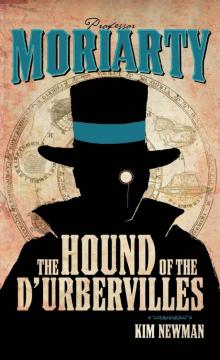 Moriarty: The Hound of the D'Urbervilles
Moriarty: The Hound of the D'Urbervilles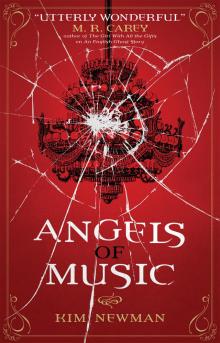 Angels of Music
Angels of Music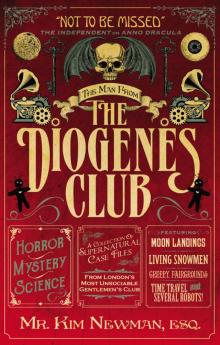 The Man From the Diogenes Club
The Man From the Diogenes Club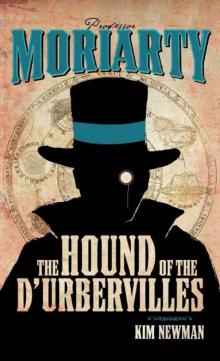 Professor Moriarty: The Hound Of The D’urbervilles
Professor Moriarty: The Hound Of The D’urbervilles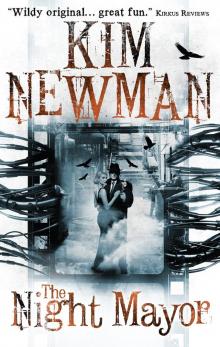 The Night Mayor
The Night Mayor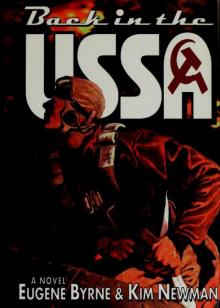 Back in the USSA
Back in the USSA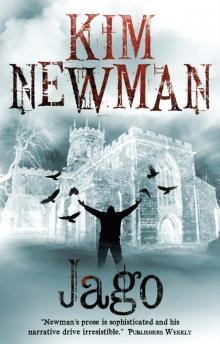 Jago
Jago Gaslight Arcanum: Uncanny Tales of Sherlock Holmes
Gaslight Arcanum: Uncanny Tales of Sherlock Holmes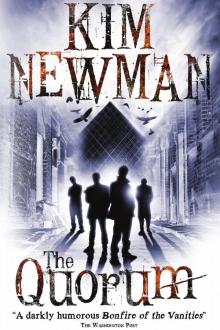 The Quorum
The Quorum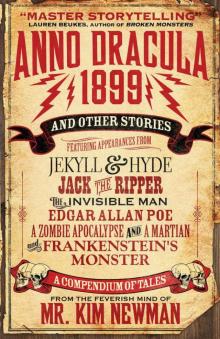 Anno Dracula 1899 and Other Stories
Anno Dracula 1899 and Other Stories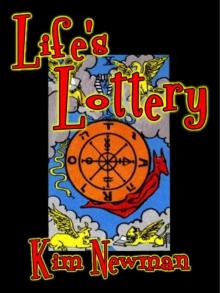 Life's Lottery
Life's Lottery The Secrets of Drearcliff Grange School
The Secrets of Drearcliff Grange School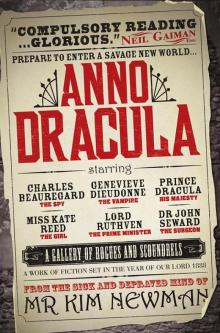 Anno Dracula ad-1
Anno Dracula ad-1 The Bloody Red Baron: 1918 ad-2
The Bloody Red Baron: 1918 ad-2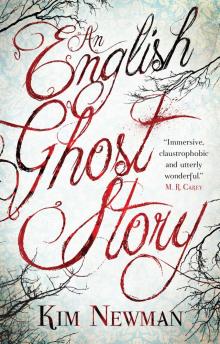 An English Ghost Story
An English Ghost Story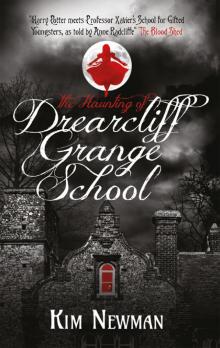 The Haunting of Drearcliff Grange School
The Haunting of Drearcliff Grange School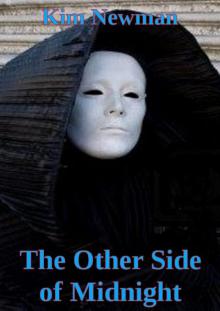 The Other Side of Midnight
The Other Side of Midnight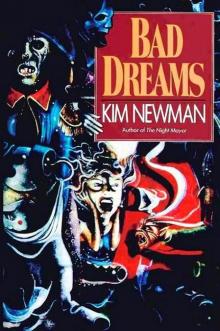 Bad Dreams
Bad Dreams Anno Dracula--One Thousand Monsters
Anno Dracula--One Thousand Monsters The Hound Of The D’urbervilles
The Hound Of The D’urbervilles The Bloody Red Baron: Anno Dracula 1918
The Bloody Red Baron: Anno Dracula 1918